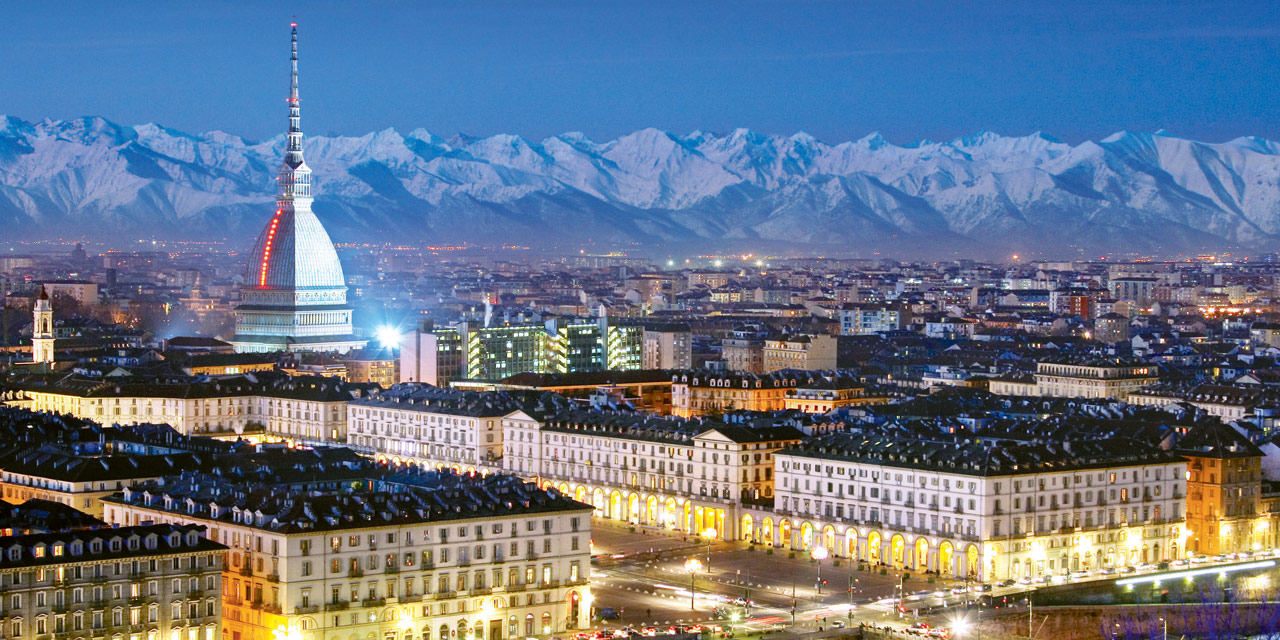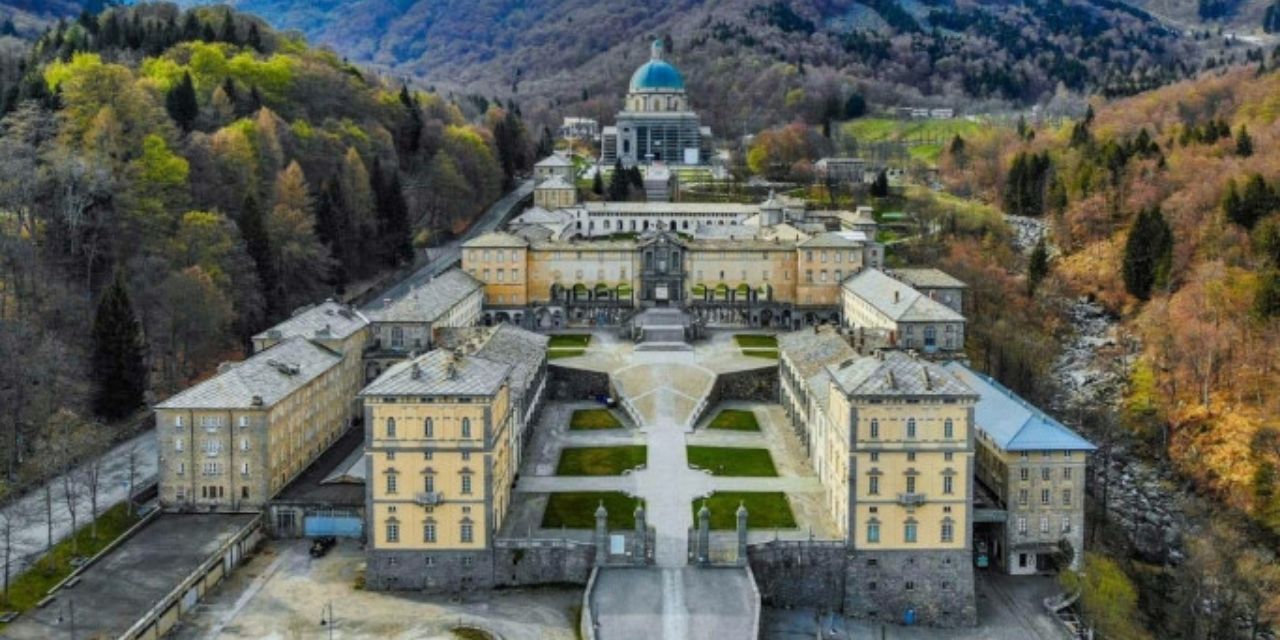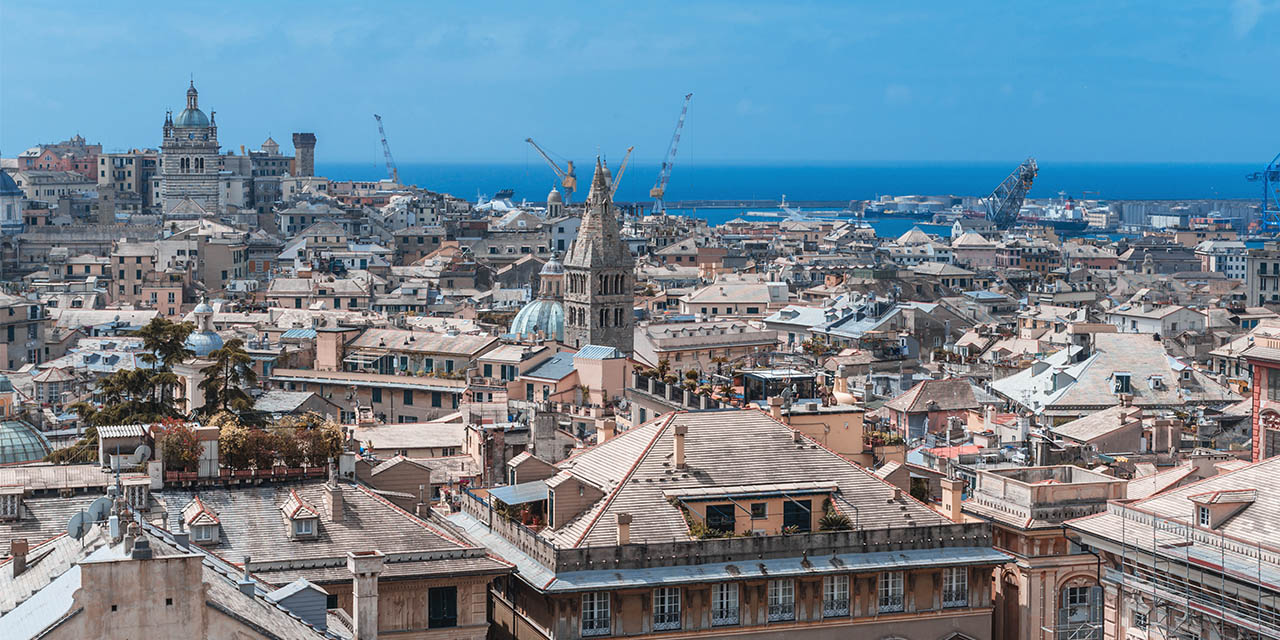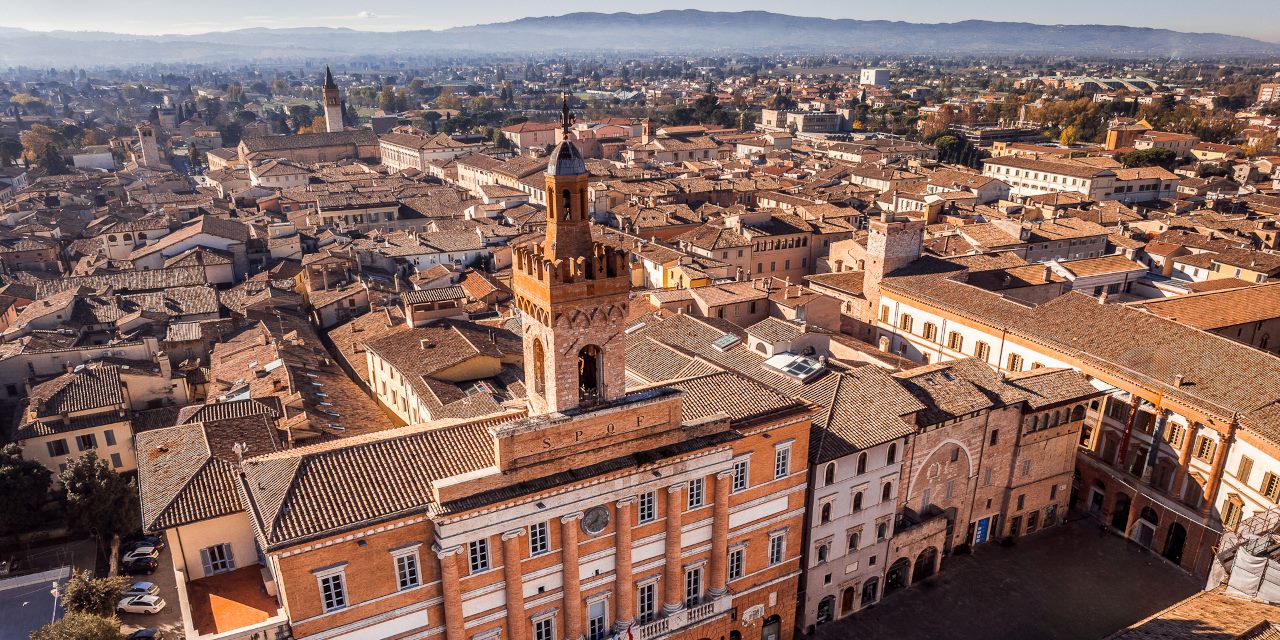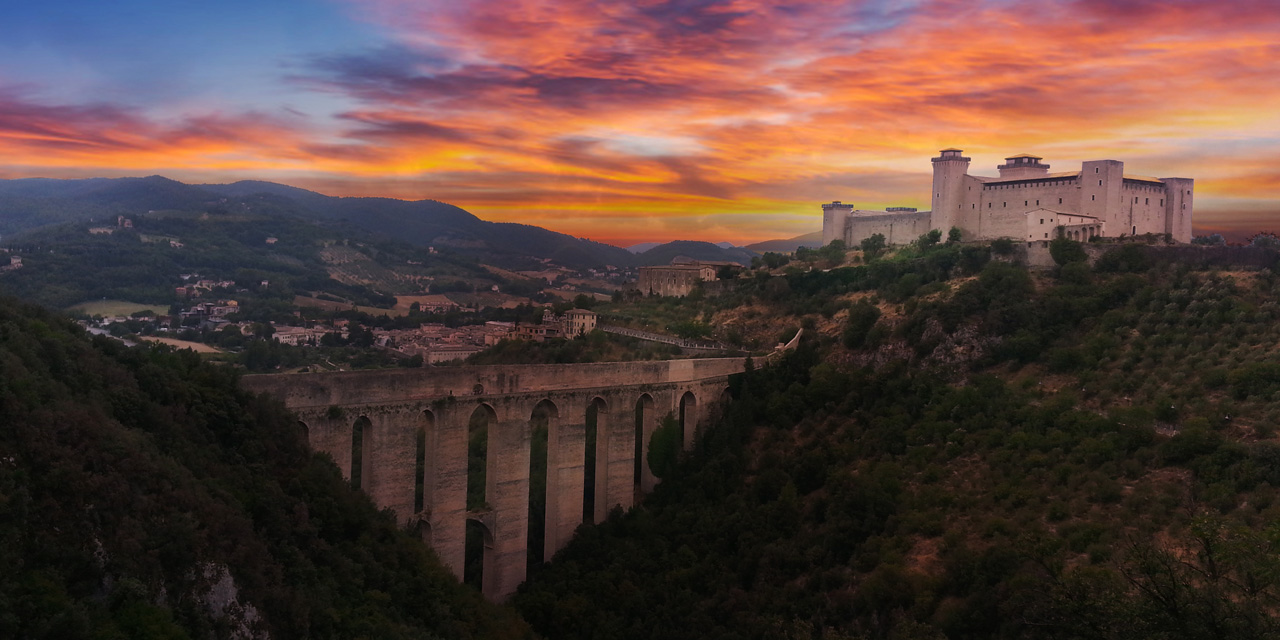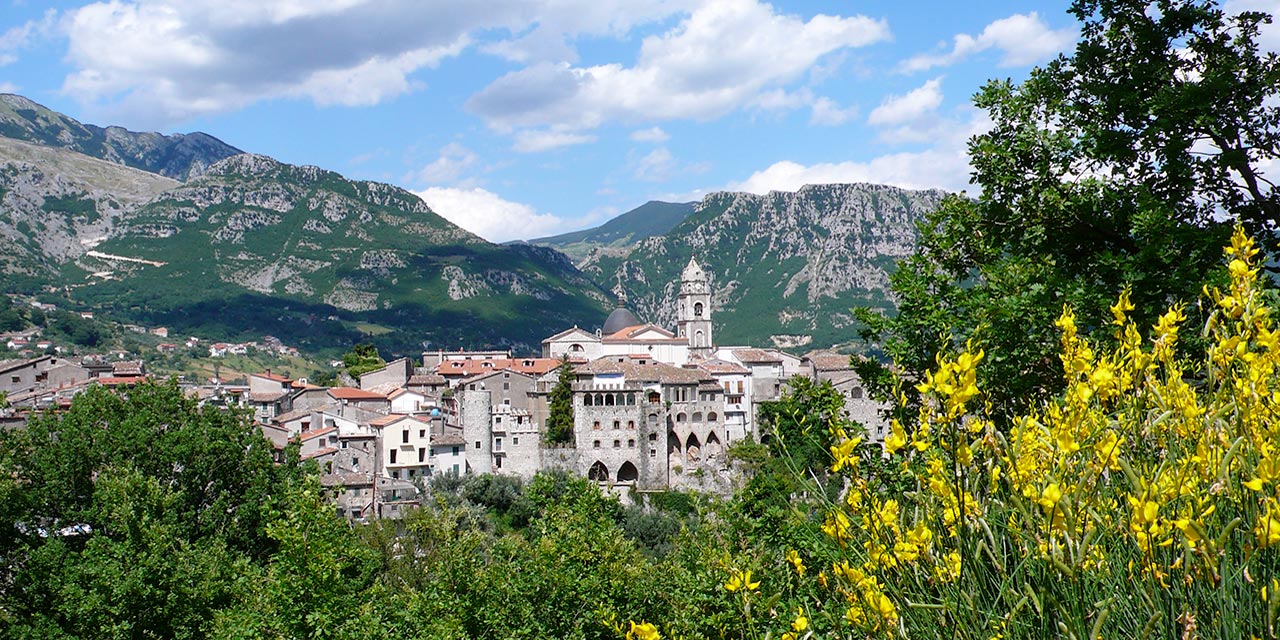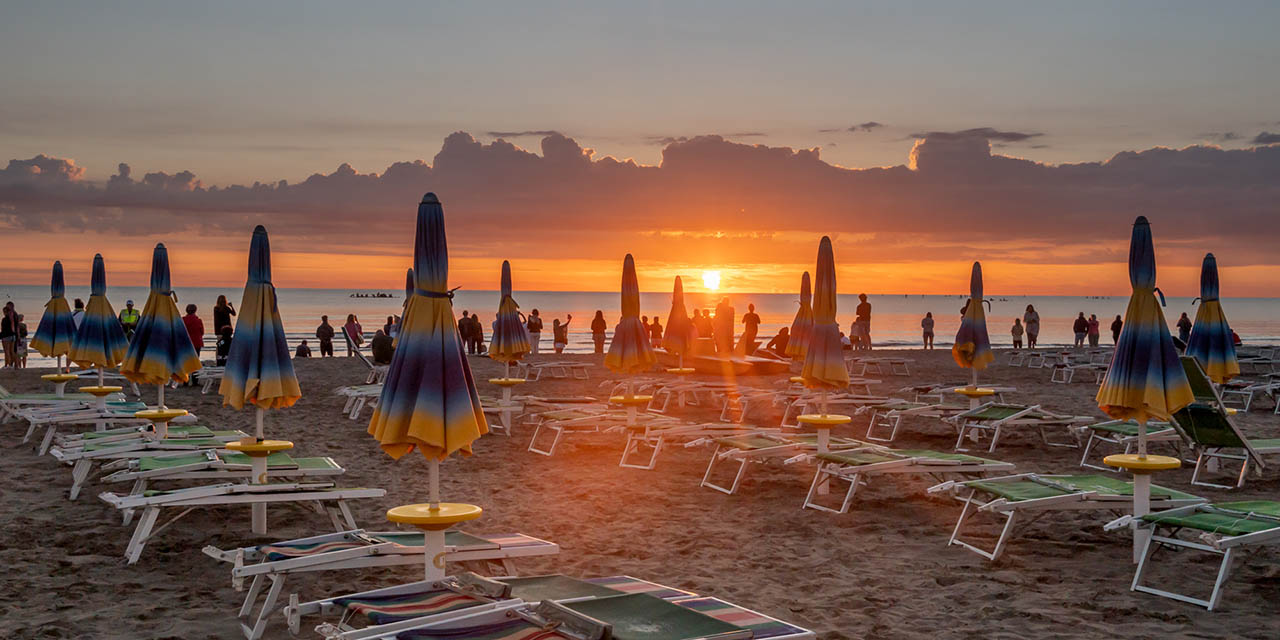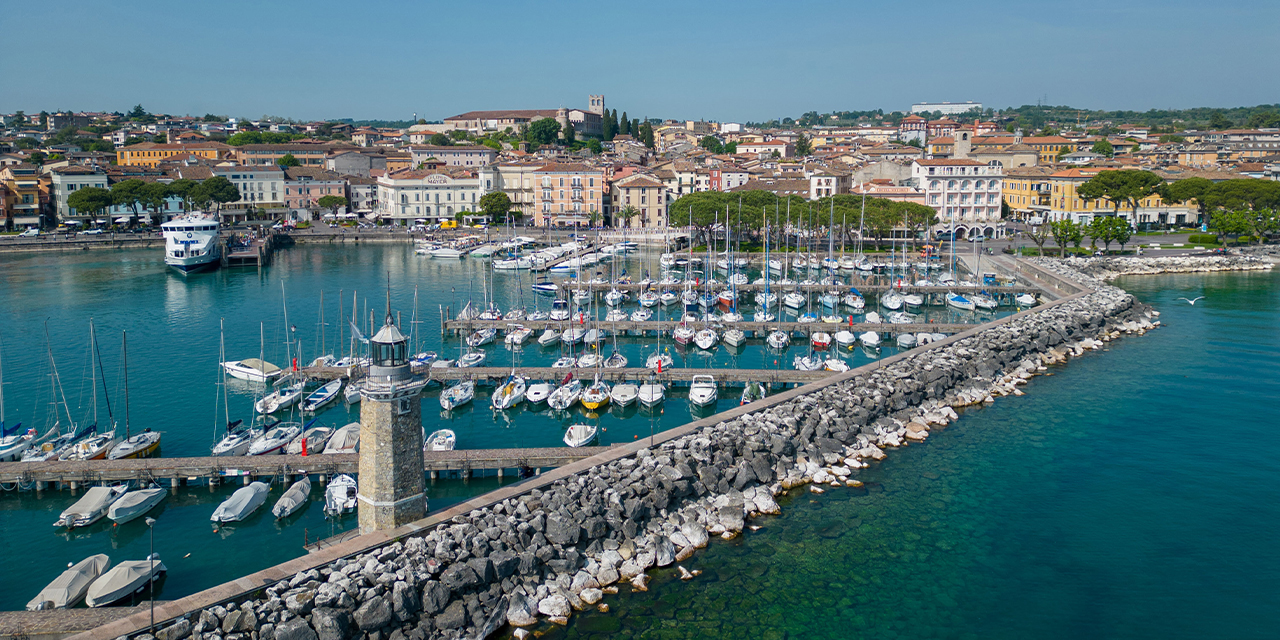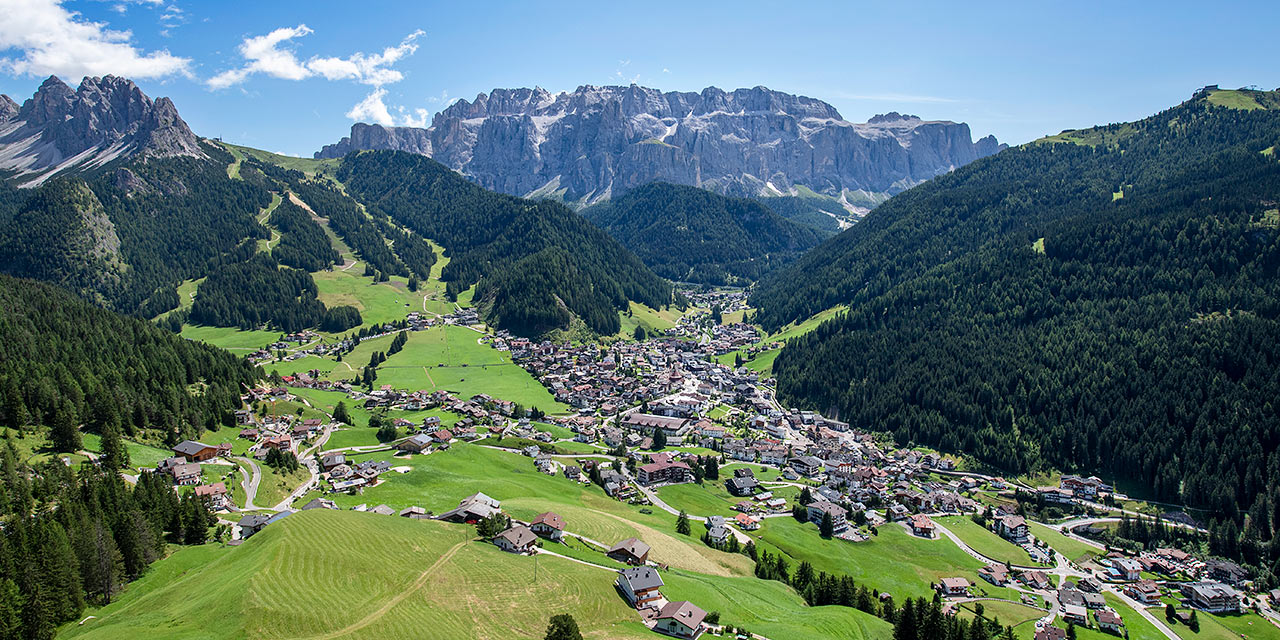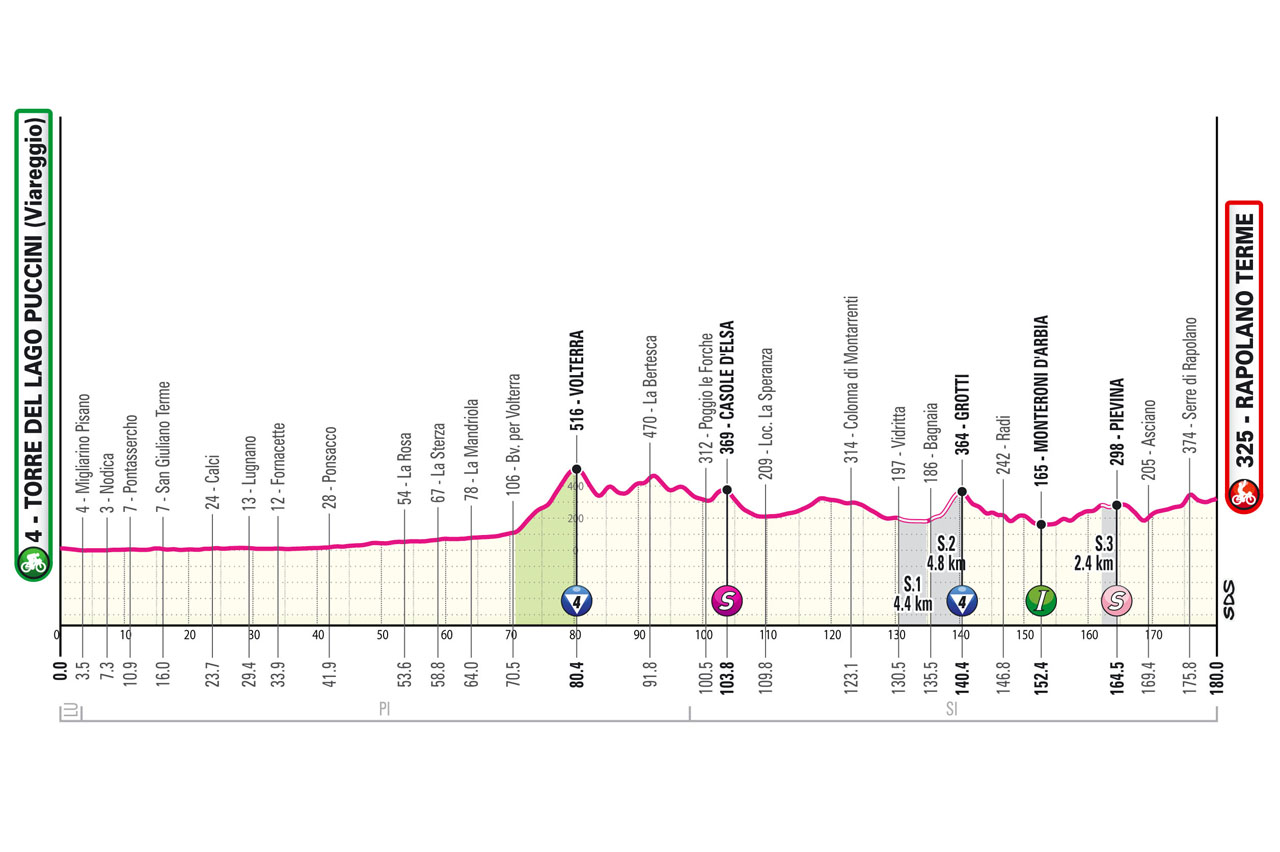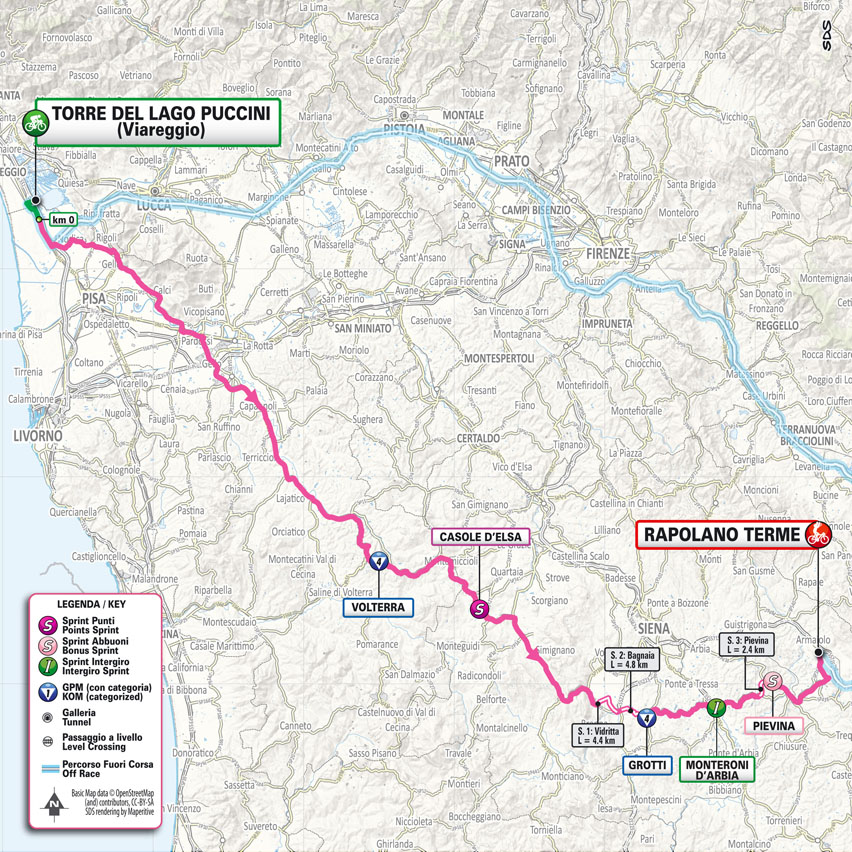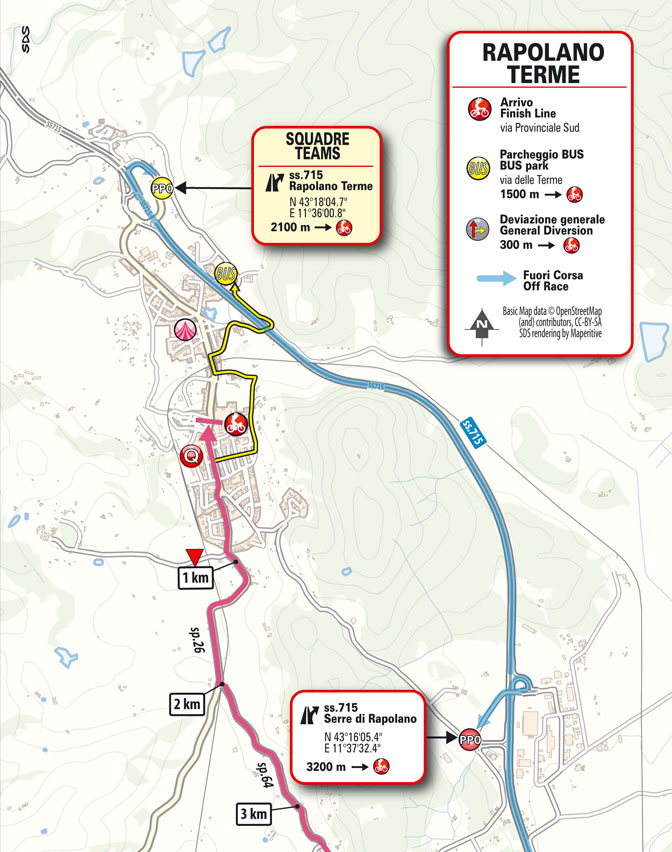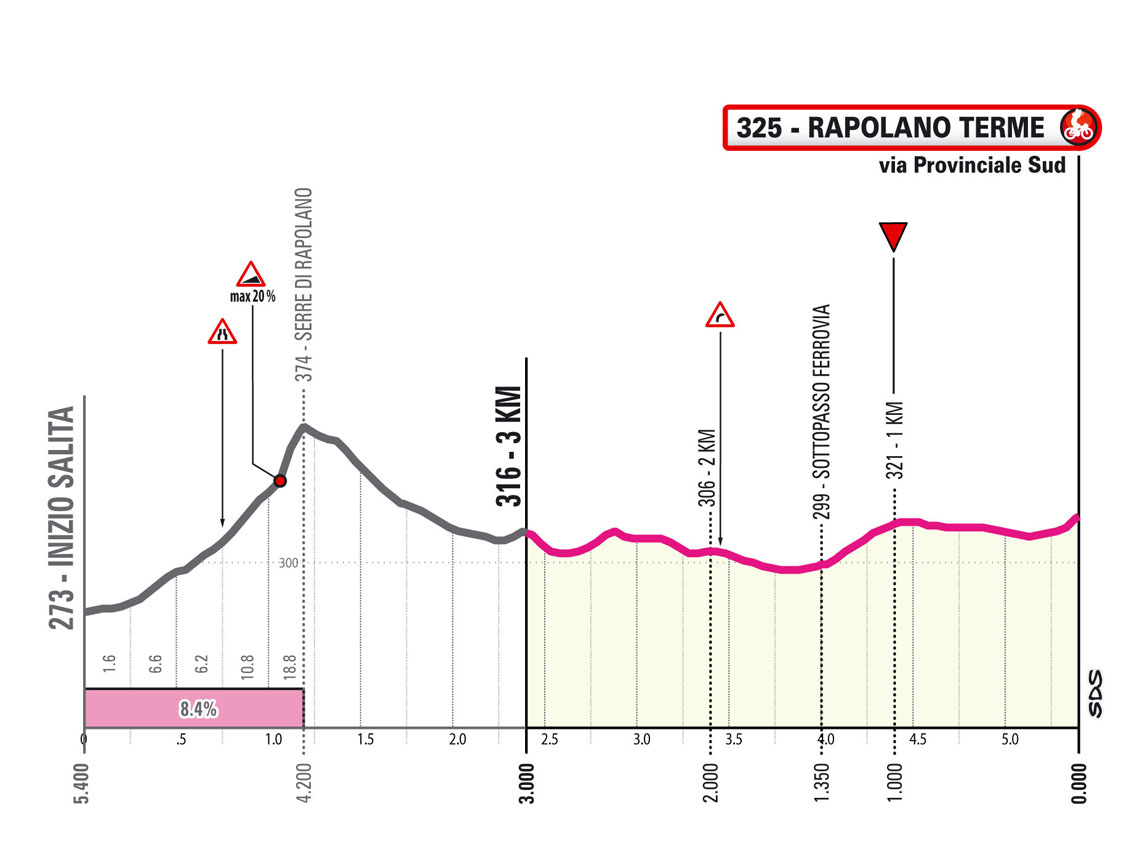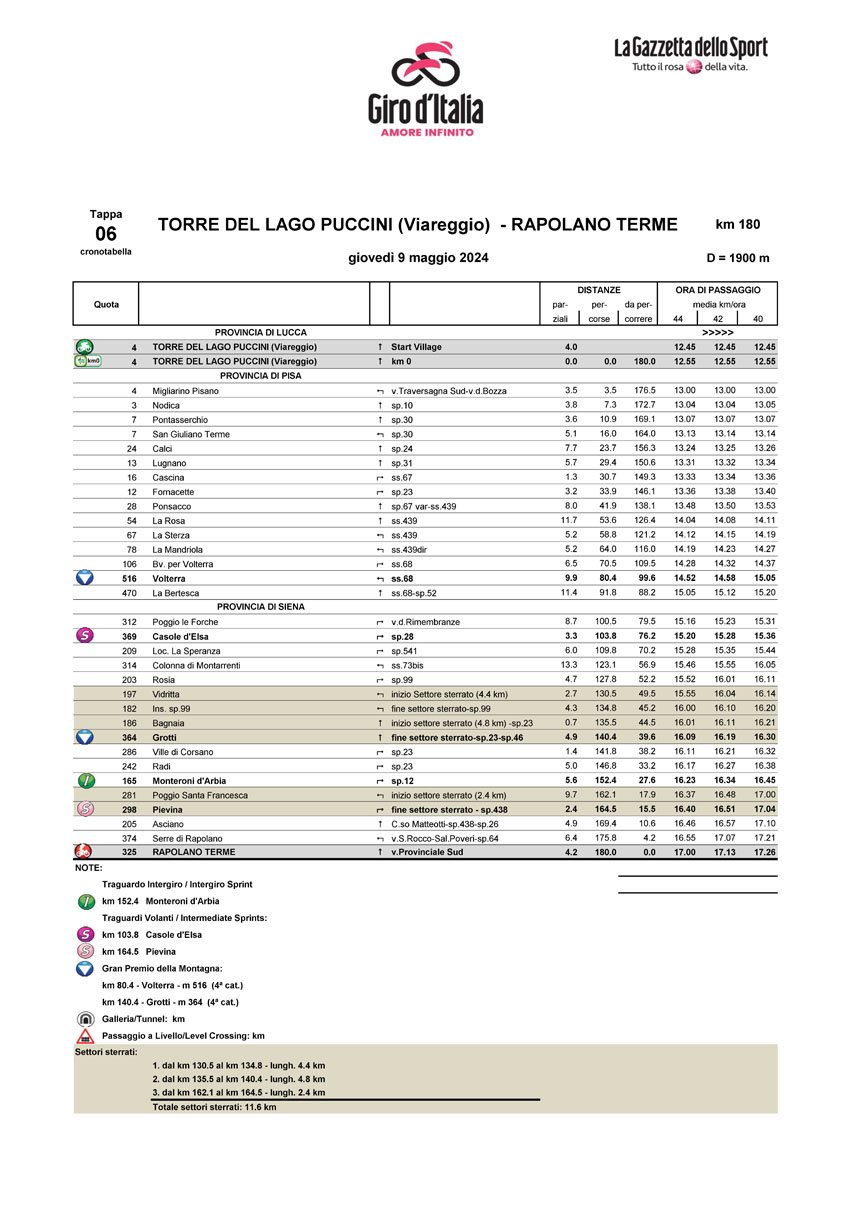profile
map
technical info
A demanding stage characterised by a hilly second part and three gravel sectors totalling almost 12 km. The first two are shared with the Strade Bianche, the third is a new one. After a flat run-up in the Pisa hinterland as far as Volterra, the peloton will enter the Senese province and face the dirt section of Vidritta, which, compared to the Strade Bianche, is 2 km longer. The Bagnaia section follows just a few hundred metres later, featuring gradients of up to 15% as well as the second KOM of the day. Before Asciano, the Pievina is tackled. Very demanding finale with the wall of Serre di Rapolano.
Last kilometres
The last km are complicated and feature tricky bends and ups and downs. Of note at about 5 km from the finish line is the Serre di Rapolano climb, with gradients of up to 20% in the finale. The final straight is a 450 m stretch on asphalt with a width of 6 m and a gradient of around 6 %.
start / finish
final kilometres
itinerary timetable
tourist info
Host city:
Torre del Lago Puccini (Viareggio)
Overview
Viareggio is mainly seen as a seaside resort because a long, sandy beach bathed by the waters of the Mediterranean flanks the town. However, it can also boast close proximity to the mountains of the hinterland, the Lake of Massaciuccoli and the protected areas of the Park of Migliarino and San Rossore. The town plays host to a number of national and international cultural and sporting events throughout the year including the Viareggio Carnival, which this year celebrates its 150th anniversary, the Puccini Festival, the Rèpaci Literature Prize and the Viareggio Cup World Football Tournament.
The warm, at times dazzling, spotlight of Viareggio sweeps across the sea to the profusion of traditional bathing establishments lining the beach and the déco architecture of the promenade and continues over the bridge before arriving in the fishing harbour. From the pier, it runs along the Burlamacca canal linking the town centre and the suburbs and reaches the dockyard home of shipyards that are renowned for building some of the most beautiful yachts in the world. And then to Torre del Lago and the home of Puccini by the lake, where the silence and stillness of the water are only occasionally disturbed by the swish of an oar or the sound of birdsong to reveal the secrets of residences from a bygone era. A glimpse of urban and seafaring life set against a backdrop that truly inspires.
Food
Traditional dishes that must be tried during a stay in Viareggio
Pasta alla trabaccolara
“Trabaccolara” is a traditional Viareggio dish made using fish that hasn’t sold at the market. The name derives from the lugger, “trabaccolo”, used by the fishermen from San Benedetto del Tronto, some of whom moved to Viareggio between the 1920s and the end of the 1930s. Fish such as gurnard, scorpion fish and weever are needed to prepare the dish, to which some cooks add shellfish (although not part of the traditional recipe). The fish is cooked with tomatoes and flavoured with wine and aromatic herbs.
Risotto with squid and chard
This risotto unites the flavours of the land and the sea and is a favourite served by the local festival street kitchens during the Carnival period. To prepare the risotto, brown the squid, add the chard cut into strips and, once this has softened, add the rice and continue until the rice is cooked; finish the dish with the chopped parsley. Buon appetito!
Viareggio style “Cacciucco”
Strictly with the double “C”s! A simple, traditional fishermen’s dish, this fish stew has been made since the 1500s. Cacciucco, from the Turkish “kuchuk” meaning “small”, would be prepared by fishermen as they returned to port from a fishing trip. The distinguishing feature of Viareggio cacciucco is that it uses the fish of little market value and which the fishermen on landing their catch would otherwise have discarded. To be served accompanied by toasted home made bread, preferably rubbed with garlic. Cacciucco fish stew has a strong and slightly spicy flavour.
Spaghetti “con i nicchi”
So what are “nicchi”? Nicchi are what people from Viareggio call the clams or cockles found on sandy seabeds. They are cooked very simply but are extremely tasty. After purging the “nicchi” of sand by placing them in a bowl of seawater for at least 12 hours, they’re sautéed in a frying pan before adding freshly cooked spaghetti. White wine, garlic and chilli pepper are used to flavour the clams and parsley is added as a final touch.
Spaghetti “con i coltellacci”
“Coltellacci” in Viareggio vernacular are otherwise known as razor shells, which owe their name to the elongated, knife-like form of these molluscs that are found along the shoreline and on rocks after storms at sea. They are prepared plain or with the addition of tomatoes and have a strong, intense flavour.
“Scarpaccia”
Finally, a dessert that isn’t sweet at all but which is usually eaten not only at the end of a meal but also as a snack during the day. A cake featuring finely sliced courgettes as the main ingredient. The resulting flavour, a mixture of sweet and savoury, delights the taste buds. Discover it for yourself!
Points of Interest
The Promenade
The Promenade of Viareggio, one of the most evocative and fascinating places of the Versilia Riviera, features the work of Alfredo Belluomini and Galileo Chini in the many prestigious art nouveau and déco buildings. Extending for 3 kilometres, locals, holidaymakers and visitors from around the world come to enjoy the quintessential holiday atmosphere of the “Passeggiata”.
The Palazzo delle Muse
Originally established as a Thalassic Hospice, in 1912 it became a permanent convalescence home for treating those suffering from tubercular diseases and also to make the benefits of a stay by the sea available to those in need. Today the building houses the municipal library, archive and the Gallery of Modern and Contemporary Art, which, offering an overview of twentieth century Italian and wider European art, is recognised as one of the most specialised galleries in Italy.
The Torre Matilde
The history of the Torre Matilde coincides with that of Viareggio and is an example of 16th century military architecture. As the silent guardian of the coast, the tower bears witness to the centuries of development of the surrounding area. After changes in fortune and use, it is now the venue for cultural events and temporary exhibitions.
The Museo della Marineria
The Museum was founded in order to display finds related to the maritime history of Viareggio and beyond. It is divided into sections dedicated to on-board equipment, shipyards, seafarers and shipwrights and caulkers.
The Casa Museo Giacomo Puccini
The house, transformed into a museum in 1925 by Puccini’s son Antonio, has remained unchanged over time and offers the opportunity to experience the atmosphere of the place where the Maestro found inspiration for his opera masterpieces.
The Villa Museo Paolina Bonaparte
The villa of Princess Pauline Bonaparte was built in 1822 on the seashore on what was then the northern edge of Viareggio to plans by the architect, Giovanni Lazzarini, for a small, secluded residence offering privacy and direct contact with nature. The Villa now houses temporary art exhibitions and is a venue for cultural events.
The Villa Borbone
Villa Borbone is certainly one of the most fascinating historical places in Viareggio. Situated in one of the many appealing parts of the Versilia Riviera along an avenue of lime trees, the “Viale dei Tigli”, the Villa has been restored for use as a multipurpose space by the Municipality and also forms the entrance to the beautiful Regional Park of Migliarino, San Rossore and Massaciuccoli. In the summer season the Villa hosts musical events, cultural festivals and theatrical performances.
The Shipyards
Viareggio is the heart of one of the most significant shipbuilding areas in Italy and is the spearhead of the region’s shipyard supply chain, which is geared to superyacht construction and services, comprising 5,000 companies and directly employing approximately 18,000 workers. With a turnover of 2 billion Euros and 95% of clients for superyachts coming from overseas, the area accounts for 50% of Italy’s revenue from this sector. The local economy linked to pleasure boating involves a wide variety of concerns, professions and trades and over 70 occupations ranging from industry to tourism. Viareggio is home to approximately 1,300 companies that are fully operational in the pleasure boating industry, with a workforce of 8,000 employed in shipbuilding, subcontracting, services and repairs, trade and rental and in the port area. 10 of the world’s leading shipbuilding brands have their headquarters in Viareggio.
Rapolano Terme
Overview
The municipality of Rapolano Terme extends between the wooded hills of Chianti, the Val di Chiana and the Crete Senesi. This stretch of land is a work of art created by the effort and hard work of farmers, artisans and the ingenuity of its inhabitants. An endless piece of land made of villages, parish churches, castles and farms.
Local Cusine
This land grows high quality products such as cereals, olives, vines, or can also be left for grazing. Excellent oil, delicious vegetables, top quality meat and fragrant pecorino cheese, made from the milk of sheep that are lucky enough to feed on the variety of herbs available in the area. The cuisine is the traditional and essential one of rural Tuscany. Vegetable soups, bread soups that become “ribollite” the next day, fresh handmade pasta, and barbecued meat. Rapolano boasts a dessert called the “focaccia rapolanese”, a delicacy that can only be tasted in local bakeries and restaurants. Two disks of short pastry and almonds enclosing a mouth-watering pastry cream.
Punti di Interesse
Rapolano Terme is synonymous with thermal waters and thus with well-being. The San Giovanni thermal baths and the Antica Querciolaia thermal complex are the right places to find comfort and give your body and mind a well-deserved moment of relaxation.
The benefits of the local thermal baths have been known since antiquity and proven by archaeological excavations attesting to the healing powers of their waters.
The vocation for wellness and well-being is complemented by trekking and biking routes that wind through an area of great scenic and naturalistic value. Of note is the Crete Senesi cycle route project.
An important village is Serre di Rapolano. The centre of the village winds around the 13th-century architectural complex of the Grancia, Granaione and Tinaia, which are part of a network of fortified farms belonging to the Sienese hospital of Santa Maria della Scala.











